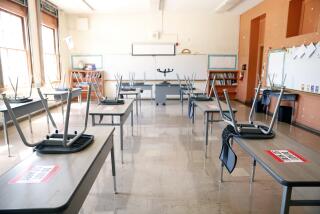Flexing their word power
- Share via
Watching a bunch of gangly middle-schoolers hopping around in their gym clothes at 9 in the morning brought back all sorts of bad memories from my own junior high school days. Still, just by watching Wilmington Middle School students in phys ed class one day last week, I learned a valuable lesson about generosity, voluntarism and just plain common sense.
I went to Wilmington to check out what I thought was a simple yet brilliant idea to help working-class students compete in the high-stakes world of educational testing.
We hear a lot about educational inequality, but we sometimes forget that inequality comes in a variety of forms. Just this month at a state summit on California’s ethnic achievement gap, actor Edward James Olmos -- famous, in part, for playing a teacher in a movie -- galvanized an audience by focusing on the institutional bias that keeps too many Latino and black students from performing well.
But like so many other activists, he didn’t mention that other form of inequality that’s a whole lot more insidious, and for which there is no one to blame. Not unlike scores of other schools throughout the Los Angeles Unified School District, Wilmington Middle School has a large share of students whose parents not only have few years of education but sometimes do not speak English fluently. Consequently, these kids don’t grow up learning the words they’ll have to know for tests that will evaluate them alongside children whose parents are native speakers with plenty of schooling.
As much as we push classroom teachers to help these students catch up, it’s not fair to expect that they can do it on their own. Lord knows, American popular culture is no help. With few exceptions, television, movies and the latest song lyrics don’t exactly raise children’s intelligence quotients. All that may broaden a kid’s vocabulary, but not always in ways that teachers or test makers appreciate. And even though schools like Wilmington enjoy healthy levels of parental involvement, it’s not reasonable to think that all the moms and dads will start reading Norman Mailer or Gabriel Garcia Marquez any time soon.
But that doesn’t mean that nothing can be done to change these children’s educational environment.
At least that’s what 26-year-old UCLA undergraduate Michael Bailey says. Last January, Bailey, a product of L.A. Unified who grew up in Lomita, no more than two miles from Wilmington, came up with an idea to help students at the middle school where his mother once worked as the attendance office clerk. After taking a class on “cognitive metaphor theory” -- the basic principle of which argues that when our brains come across something abstract or unfamiliar, we relate it to something familiar in order to understand it -- Bailey tried to come up with ways for kids to better familiarize themselves with words. The idea was to give kids an image of words and their definitions on an object; linking one with the other would make remembering words and their meanings easier.
First he considered cafeteria trays, then folders. Finally, he came up with a better medium: phys ed shirts. “Since our brain picks up words and images and relates them to something we’ve already experienced,” he said, “my hope was that during state testing, students would have images of their classmates’ shirts come to mind.”
After school officials agreed to the plan, Bailey set up a nonprofit organization and raised about $5,000 to help pay for some of the shirts. Wilmington Middle’s assistant principal, Peter Hastings, said that working with Bailey was a “no-brainer.” Together they came up with a list of 100 words and simplified definitions that would go on the backs of the 6th-, 7th- and 8th-graders, one word and definition per shirt. They chose from a list of “high incidence” academic words, ones that kids are likely to encounter on tests.
But how does it play on the playground? Some cool kids at Wilmington denied knowing which word was on their back, even when they were wearing the shirt. But it wasn’t hard to get them to cough up what words their classmates were wearing. Some words were more desirable than others. In fact, one of the most popular -- “available” -- was nixed by the powers that be for its unintended additional definition.
Sixth-grader Javier Mosquera was only too proud to say that his word was “evident.” What does it mean? “To be clear and obvious,” he said. Likewise, 11-year-old Rebecca Ramirez rattled off the definition of “contract”: “an agreement between one or more people or parties.” She seemed to know the definition of a lot of the other words her classmates were wearing.
Just after the experiment started, her phys ed teacher, Mr. Tussing, tested his students on how many of the T-shirt words they knew. “For the most part, they did real well,” he said. “I’d like to see some more P.E. words, though, maybe words like ‘aerobic,’ or the muscle groups.”
Bailey says he hopes to know more about whether his idea works when Wilmington’s test scores are released at the end of the year. But I think success is already in the bag. When’s the last time you heard of a phys ed teacher testing his students on their vocabulary?
More to Read
Sign up for Essential California
The most important California stories and recommendations in your inbox every morning.
You may occasionally receive promotional content from the Los Angeles Times.










